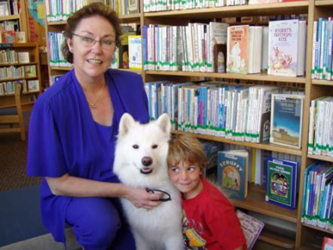Many of us have walked into a nursing home or hospital to visit a friend or volunteer some time cheering up patients. Ever thought of taking your dog? It’s wonderfully rewarding, but not for all dogs.

Many dogs are well-behaved, follow basic commands, and with practice can walk calmly on a leash while indoors. Not all dogs, even our wonderful Samoyeds, have the temperament to be therapy dogs. They love you, of course. But being pestered by strangers who are ill or in pain just isn’t for all dogs. Some dogs are great with adults but are overly excited or frightened of children. This is especially important to identify in order to prevent bites.
Even the sweetest dog can be provoked into a bite when multiple fingers suddenly appear at their face without warning. Owner/handlers should intervene to protect their dog and instruct children to ask before touching a dog they don’t know. Handlers can help by holding the dog’s collar securely and even gently place their other hand under the chin and to one side to prevent the dog’s head from turning suddenly toward an outstretched hand. I ask children to be gentle and pet the dog on their back rather than near the mouth. We should all do our part to teach children safe behavior around dogs. It will save everyone problems.
Therapy dogs can be owner trained and assessed and visit at some nursing homes. Fewer and fewer nursing homes allow this as all are eager to only allow Canine Good Citizens to visit. Purebred and non-purebred dogs that can pass a basic skills test from the American Kennel Club can earn the title Canine Good Citizen (CGC). See www.akc.org when tested by an AKC approved evaluator. The Barbary Coast Samoyed Club has a CGC evaluator. The CGC test and other similar assessments (Delta Society and Therapy Dogs International) can also earn 250 points toward a Working Samoyed title if 15 hours are completed (for an additional 10 points/hour or a total of another 200 points). To be sure of the latest point scale requirements, see the SCA Working Samoyed Program page.

Consider taking the Therapy Dogs International assessment too (it isn’t called a test). Dogs pass the same skill tests in the CGC. They also must walk through a small group of people with medical equipment (canes, wheelchairs, coughing participants, etc.), walk past food on the ground while on a leash (verbal reminders ok - lunges for food are not ok), and most importantly, demonstrate to the TDI evaluator that they enjoy physical contact with humans - not just tolerate it, and definitely not pull away or fear it. Go to TDI to check out the assessment or find a TDI evaluator.
One last note. Therapy dogs are different than service dogs. Service dogs include seeing eye dogs, hearing-assistance dogs, seizure-alert dogs and so on. Service dogs are working at all times and are not to be touched by anyone other than their own handler. By law, service dogs may go anywhere their owner does.
Therapy dogs sometimes wear a patch that says “please ask to pet me” or “it’s ok to pet me”. They visit multiple patients or libraries where children read to them (children are much less inhibited when reading “to the dog” than to an adult). Therapy dogs and handlers may go where nursing homes and hospitals permit them, and are not permitted in food preparation areas. They shouldn’t visit during patient mealtimes. Be a responsible dog owner. Share the dog with good behavior and good temperament with the world and visit nursing homes and other places that welcome therapy dogs. Sammies who fit the requirements are some of the best therapy dogs!